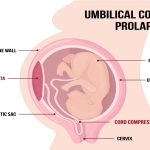
Foetal Station During Labour And Delivery
6 min readWritten by Sindhuja Prabhu


Every woman tracks her pregnancy. They know which week and which trimester they are in. they track the movement and development of the baby and understand what they can expect in each trimester until it is time for the birth. Similarly, doctors delivering the baby have their own way of tracking and measuring the readiness of the baby to come out. One of the methods is known as a foetal station during labour and delivery.
The baby, once ready for delivery, can pass through the birth canal in many different ways- head first, feet first, buttock first, sometimes, even a shoulder first. This position is very important for the doctor who is delivering the baby. In addition, they also calculate the descending of the baby based on the position to decide when the baby is ready to come out. This article explains everything you need to know about foetal stations and presenting positions and their significance during labour and delivery.
In This Article
- Video Of Fetal Station During Labor And Delivery
- What is Foetal Station During Labour And Delivery?
- How Do I Know Which Station My Baby is in?
- Foetal Station Chart
- Pros of Foetal Station During Labour And Delivery
- Cons of Foetal Station During Labour And Delivery
- How to Document a Foetal Station During Labour And Delivery?
- FAQ’s
Video Of Fetal Station During Labor And Delivery
What is Foetal Station During Labour And Delivery?
As the time nears for delivery, the baby “drops” and gets ready to make its way out of the mother, into the world. This does not mean the baby will be born in a day or two. Dropping, also known as lightening, can happen anywhere between 4 to 3 weeks before the time for delivery.
Once the baby drops down the pelvis, the doctor will measure which station or position the baby is in. The foetal station is nothing but the position the baby is in around the time of delivery. If the baby’s head engages in the 36th week, then the doctor will start measuring the descent in “stations”.
The foetal station starts with a -5 and goes on till +5. -5 is when the baby is still way up in the pelvis and + 5 is when the baby starts crowning. The station represents the position of the “presenting part” of the baby.
Presenting Part is the part of the baby that is closest to the cervix. It is the part that leads the baby all the way through the birth canal. The ideal fetal station or position is the head-down position. This makes passing through the birth canal as well as delivery easier. But as we all are aware, a baby’s position is completely unpredictable. In many cases, the “presenting part” of the baby can be its feet, buttocks, or even the shoulders.
[Read : When Does The Baby Drop During Pregnancy?]
How Do I Know Which Station My Baby is in?

Your doctor will conduct vaginal exams once the baby drops. During these exams, the doctor will measure which station the baby is in. You and your doctor may not discuss these foetal stations and measurements until the very end of your pregnancy. Sometimes you may hear these terms only when you are already in labour. This is because there is no need to discuss or measure until the baby actually drops and is ready to be born.
Every point that reduces in the foetal station measurement indicates a descent of 1 cm by the baby – meaning, if your doctor says the bay has moved from -3 to -1, then it means your baby has descended 2 cm since the last measurement.
The doctor can mostly carry out these measurements just by checking with their hand. They will feel for the baby’s head and ischial spines (the narrowest part of the mother’s pelvis) and give out the measurement. If needed, they might sometimes do an ultrasound to get a more accurate reading of the baby’s position.
The “foetal stations” measurements can vary from doctor to doctor because in most cases they do a rough calculation by just feeling for the head above the surface of the mother’s body.
Foetal Station Chart
Let’s get a better idea about the foetal stations by delving into the actual numbers:
As mentioned earlier, the measurement starts in negative and moves on to positive digits.
| Representing Number | What it Means |
| -5 | This station indicates the baby is a floating baby. This is when the baby has dropped but the doctor is still not able to feel the baby’s head, and so cannot determine the baby’s position exactly, in correlation to the ischial spine. |
| -3 | This station indicates the baby’s head is just above the mother’s pelvis. So the baby is moving down to the ischial spines of the mother |
| 0 | This station indicates the baby is fully aligned with the mother’s ischial spines and is now engaged. Once the head is engaged, you can expect the baby to be born anytime within the next two weeks. For most first time moms, it will take close to two weeks. However, in some cases, the baby’s head will engage only during active labour. |
| +3 | This station indicates the baby is descending beyond the ischial spine and is in the birth canal. |
| +5 | This is the final foetal station. This is where the crowning begins and in a few short minutes, your baby will be born. |
Pros of Foetal Station During Labour And Delivery
Measuring the foetal station has the following advantages –
- This is a pain-free method to find out about the baby’s position.
- It helps the doctor to understand how the baby is moving down the birth canal.
- This method is as effective as the ultrasound exam to determine the position and progress of the baby down the birth canal.
- The measurement is very important if the doctor needs to deliver the baby using forceps or vacuum.
[Read : Vacuum Assisted Birth – Everything You Need To Know]
Cons of Foetal Station During Labour And Delivery
There are a few disadvantages to this method of measurement too –
- The measurement can be very subjective as each doctor might perceive the baby’s position differently.
- If more than one doctor is involved (say a junior doctor checks the foetal station and informs the main doctor the baby is ready) there is room for miscommunication.
- Checking the foetal station too many times may make it very uncomfortable for the woman in labour. It might even increase the chances of vaginal infection.
- If the baby’s head is elongated in shape, it can cause a false or wrong reading.
- In case the baby is presenting face forward, assessing the foetal station can be tricky.
How to Document a Foetal Station During Labour And Delivery?
The foetal station measurement is very subjective and can vary from doctor to doctor. It is usually documented in negative or positive numbers. It can start with a -5 and will go all the way to +5, which is when the crowning happens.
Your doctor will check and make note of the foetal station on your chart so that everyone around is also aware of the baby’s position.
Measuring the foetal station during labour and delivery is an important method most doctors use to keep a track of the baby’s descent depending on the measurements and the presenting position of the foetus. Having said that, this method can be very subjective and vary from one doctor to another. For this reason, it is not a precise method of measuring.
[Read : Getting Your Baby Into A Good Position For Birth]
FAQ’s
1. Does Station “0” Mean it is Time For Delivery?
No, 0 station means the baby’s head is fully engaged. This can happen during active labour or as early as two weeks before labour. It indicates that the baby is ready to be born very soon.
2. Which Foetal Station Should my Baby be in at The Time of Delivery?
The baby should be in +4 or +5 during delivery. This is when the baby will be very close to the cervix and start crowning. When the doctor says the baby is at +5, it means the baby is coming out and they are able to see the baby.
3. At Which Foetal Station Will They Start The Delivery Process?
It depends on the mother. For some women, the head will engage (station 0) only during the delivery. For some women, the baby can start descending as early as the 36th week. Different women will start “delivering” the baby at different times. The only consistency is that the baby will be out when it reaches station +5.
Read Also: A Brief on Labor Signs and Stages

Sindhuja Prabhu,M.Sc (Psychology),PGDBM
Sindhuja, a mother of two, is an obsessive mom with a keen interest in psychology, especially child psychology. Her quest for knowledge and way with words led her to become a passionate content writer. She transformed her love for writing into a full-fledged career which incidentally also turned up being the perfect stress buster for the last 5 years.Read more.
Responses (0)
Want curated content sharply tailored for your exact stage of parenting?
Related articles

Top 500 Baby Boy Names That Start With O

Seaweed During Pregnancy – Is it Safe Have, Health Benefits and Risk Associated

Umbilical Cord Prolapse – Causes And Tips To Manage

Eye Twitching During Pregnancy – Causes, Symptoms, and Top Remedies

Stuffy Nose During Pregnancy – Causes and Home Remedies

Samosa During Pregnancy – Is It Safe to Eat?
Sponsored content
Discover great local businesses around you for your kids.
Get regular updates, great recommendations and other right stuff at the right time.





